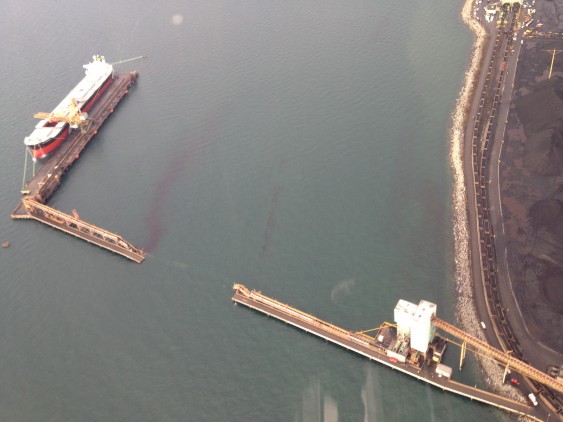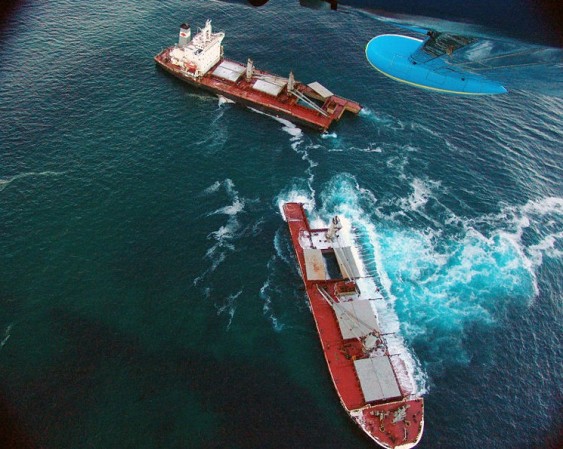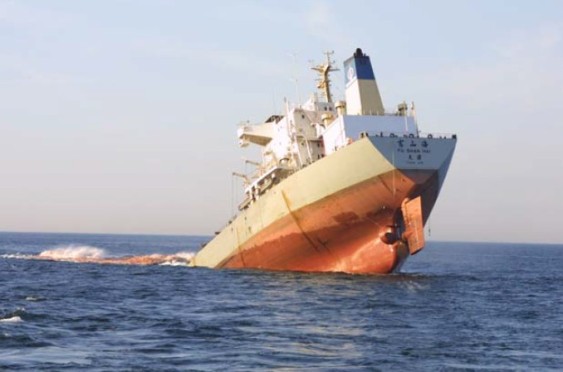It was dark but it wasn’t stormy when the Salish Sea saw its first recorded sinking of a coal vessel. At 6:45 a.m. on November 21, 1886 the Barnard Castle, a freighter laden with 2,300 tons of Vancouver Island coal bound for San Francisco, struck the Race Rocks about 10 miles southwest of Victoria. The captain managed to beach the foundering ship in a shallow bay at nearby Bentinck Island. Workers were later able to remove much of the coal before abandoning the ship where it remained lodged in the mud until it was eventually destroyed by storms.
The region’s second recorded sinking happened just five years later, on November 28, 1891 when the iron steamship San Pedro came to grief while carrying 4,000 tons of coal from Vancouver Island to San Francisco. In dead calm waters at about 8:30 p.m. the ship struck a submerged ledge near Trial Island just off Victoria. Rescue tugs arrived a few hours later and removed some of the coal before the vessel sank suddenly into shallow water.

Fast forward a little more than 120 years. British Columbia maintains a robust coal export industry that sends hundreds of coal-laden vessels through the Salish Sea, mostly in safety. Yet 2012 very nearly saw the region add another coal carrier to history’s list of casualties when the apparently out-of-control Cape Apricot smashed through a loading trestle at BC’s Westshore coal terminal.
The recent explosion of proposals for Northwest coal port expansions and new terminals has many in the region wondering just how safe are the giant bulk carriers that move coal across the Pacific. The proposed coal terminal at Cherry Point, Washington would add 974 bulk vessel trips through the San Juan Islands every year, a prospect that has plenty of observers worried. What would happen if one of these vessels were to go down?
Surprisingly, given the volume of the global coal trade, we know very little about how coal would affect the Northwest’s sensitive marine environment. We do know, however, that two recent studies of the old collier shipwrecks off Vancouver Island indicate that the sunken vessels remain to this day a source of polycyclic aromatic hydrocarbons (PAHs) and other nasties in the vicinity of Victoria, but that their contribution is smaller in magnitude and less harmful than that city’s (notoriously bad) sewage outfall and other man-made sources. (In a subsequent blog post, I will explore in more detail the scientific literature on coal’s interaction with aquatic environments.)
The major risk posed by coal carriers in the Salish Sea may not be from the coal itself but from fuel spillage, given that bulk vessels may have well more than a million gallons of low grade bunker fuel in the tanks, a worrisome prospect to local fishermen and residents.

Of course, even after they leave local waters, cargo vessels can run afoul of hazards. One of the greatest dangers may be in a remote portion of the Aleutian Islands where trans-Pacific vessels routinely pass through narrow Unimak Pass. As Floyd McKay points out in an excellent piece on vessel traffic risk from coal exports, the specter of increased tar-sands crude oil traveling through Unimak Pass is worrying many observers:
This produces severe risk to fish, according to Bellingham consultant Barry Wenger, a former Ecology senior planner who fears severe damage to salmon because of increased tanker traffic through Unimak Pass, a narrow outlet in Alaska’s Aleutian Islands where traffic is essentially unregulated and where there’s a lack of recovery equipment and vessels. A spill in the region could mean “the end of salmon in the Northwest,” Wenger warns, because of the huge number of salmon smolt mingling with tankers in the Aleutians. Cherry Point coal ships would add to the Unimak traffic, already about 4,500 large ships a year, according to an Aleutian Islands Risk Assessment report.
In fact, at least one major cargo vessel has recently gone down in the Aleutians. Carrying 60,000 tons of soybeans from Seattle to China in November 2004, the Selendang Ayu experienced serious engine failure shortly after navigating Unimak Pass and began drifting. Despite coordinated rescue attempts, the ship eventually ran aground and broke apart killing six crewmen. According to Wikipedia, the ship spilled hundreds of thousands of gallons of bunker fuel.
Increasing coal vessel transits through Unimak Pass by thousands more each year—a likely prospect if even a few of the coal export plans come to fruition—would further increase the dangers to Alaska’s waters and wildlife.
Needless to say, the hazards of bulk carrier operation are hardly confined to the shores of North America. Consider the risks offshore of the world’s most prolific coal exporter, Australia. A 2012 government investigation based on pilot reports found that along the Great Barrier Reef one collision risk event occurs approximately every month. And the risks are not just theoretical: a Chinese-Japanese joint venture-owned coal bulker ran aground on the Great Barrier Reef in 2010.

Around the world, bulk carrier accidents are far more common than you might think. Just a handful of examples clarifies the dangers. A Chinese bulk carrier loaded with fertilizer sank off the coast of Denmark in 2001 after it collided with a container ship.
Later in 2001, the Christopher departed Colombia carrying 160,000 tons of coal bound for the United Kingdom, but at roughly 10:35 p.m. on December 22 it foundered and sank near the Azores, killing all 27 crew members aboard.
The Alexandros T sank off the coast of South Africa while carrying 155,000 tons of iron ore in 2006.
On Christmas Day 2012, the the bulk carrier Vinalines Queen, carrying nickel ore from Indonesia to China, went down killing everyone aboard.
So many bulk vessels have been damaged or sunk in recent years that I could not list them all here. According to Stan Cox, a freelance writer and author of a report called “Death Trips on the Seven Seas,” “the decade from 1996 to 2005 saw 420 cargo-vessel sinkings, groundings, collisions, and other wrecks that caused fatalities.” (Lamentably, the report does not include citations.)
As global coal exports have ramped up over the last few years, so have high profile coal vessel accidents. A coal ship sank on the Yangtze River in 2011 carrying 4,500 tons of coal. That same year, a freighter ran aground and sank near Mumbai, carrying 60,000 tons of coal, 290 tons of fuel oil, and 50 tons of diesel fuel. Several days later, oil was still leaking from the ship at 1.5 to 2 tons per hour.
The bulk cargo shipping industry comes with inherent risks, but in the Northwest, it has so far managed to avoid any serious catastrophe. Whether the region can continue its streak in an era of rapidly escalating fuel shipments—of Wyoming coal, Alberta oil, and BC natural gas—is not a question that should be left to luck alone. The risks, both economic and ecological, of vessel accidents in the Salish Sea deserve a thorough and public evaluation by both American and Canadian authorities before the region plunges headlong into an unprecedented fossil fuel rush.
Update 2/12/13: Via Fred Felleman, I learned that the Northwest has had at least one additional near miss with a coal vessel sinking. In 1997, the Continental Spirit, bound for the Westshore Coal Terminal, lost power and drifted more than three miles in just 30 minutes. The vessel eventually arrested just off a hazardous reef near Patos Island (a small island in the San Juans north of Orcas Island). The vessel was empty of coal, but carrying 600 tons of heavy oil and 80 tons of diesel fuel.
Also from Felleman, a bulk carrier transporting nickel ore just went down near the Philippines killing 14 of the 24 crew members. (Nickel ore is apparently a notoriously dangerous commodity owing to its propensity to turn into a slurry that can slosh forcefully in the holds.)
Update 8/20/13: A coal freighter ran aground and broke apart off the coast of South Africa.
Many thanks to Sightline Fellow David Kershner who provided invaluable research to make this blog post possible. For my description of the Northwest’s first two coal vessel wrecks I relied heavily on Anthony Dalton’s 2010 book, “The Graveyard of the Pacific.”


Comments are closed.